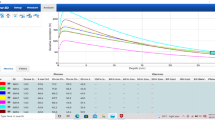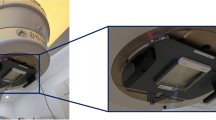Abstract
Megavoltage linac photon outputs are determined using the IAEA TRS-398 and TRS-277 codes of practice and the results compared. It is found that for two types of thimble chambers the contributions to absorbed dose to water due to the two codes of practice are comparable and it is suggested that observed differences are mainly due to the different standards used to determine NN D,w , andN K calibration coefficients at a standards laboratory. A method is proposed to determinea priori the expected difference between absorbed dose to water from the two codes of practice. The contribution to the difference that depends on the respective codes is expressed by a code dependent factorf c. It is shown that for Wellhöfer FC65-G and NE 2571 ionisation chambers this factor is largely independent of beam quality. To calculate the expected shift in absorbed dose to water when moving from TRS-277 to TRS-398, anf c value which is representative of the range of beam qualities in the clinic is calculated and multiplied by the ratioN D,w/N K.
Similar content being viewed by others
References
Absorbed Dose Determination in External Beam Radiotherapy. An International Code of Practice for Dosimetry Based on Standards of Absorbed Dose to Water, Technical Report Series No. 398, IAEA, Vienna, 2000.
Absorbed Dose Determination in Photon and Electron Beams: An International Code of Practice, 2nd Ed., Technical Report Series No. 277, IAEA, Vienna, 1997.
Absorbed dose determination in photon and electron beams: an adaptation of the IAEA international codes of practice, 2nd Edition, Australasian College of Physical Scientists and Engineers in Medicine, 1998.
Shortt, K. R., Izewska, J., Meghzifene, A., Pernicka, F., Vatnitsky, S. and Zimmermann, B.,International Symposium on Standards and Codes of Practice in Medical Radiation Dosimetry — Recommendations, AbsDos 2003 — Workshop on recent advances in absorbed dose standards, Australian Radiation Protection and Nuclear Safety Agency, Melbourne, 2003.
Andreo, P., Huq, M. S., Westermark, M., Song, H., Tilikidis, A., DeWerd, L. and Shortt, K.,Protocols for the dosimetry of high-energy photon and electron beams: a comparison of the IAEA TRS-398 and previous international Codes of Practice, Phys. Med. Biol. 47, 3033–3053, 2002.
Fourie, O. L.,The calibration of a Scanditronix-Wellhöfer thimble chamber for photon dosimetry using the IAEA TRS-277 code of practice, Australas. Phys. Eng. Sci. Med, 27, 33–36, 2004.
The use of plane parallel ionisation chambers in high energy electron and photon beams: An international code of practice for dosimetry, Technical Report Series No. 381, IAEA, Vienna, 1997.
Followill, D. S., Tailor, R. C., Tello, V. M. and Hanson, W. F.,An empirical relationship for determining photon beam quality in TG-21 from a ratio of percent depth doses, Med. Phys., 25, 1202–1205, 1998.
Gastorf, R., Humphries, L. and Rozenfeld, M.,Cylindrical chamber dimensions and the corresponding values of A wall and N gas /(N x A ion ), Med. Phys., 13, 751–754, 1986.
Johansson, K.-A., Mattsson, L. O., Lindborg, L. and Svensson, H.,Absorbed-dose determination with ionization chambers in electron and photon beams having energies between 1 and 50 MeV, National and International Standardization of Radiation Dosimetry (Proc. Symp. Atlanta, 1977), Vol. 2, IAEA, 243–270, Vienna,1978.
Huq, M. S. and Andreo, P.,Advances in the determination of absorbed dose to water in clinical high-energy photon and electron beams using ionization chambers, Phys. Med. Biol. 49, R49-R104, 2004.
Implementation of the international code of practice on dosimetry in radiotherapy (TRS 398): Review of testing results, IAEA-TECDOC-1455, IAEA, Vienna, 2005.
Palmans, H., Nafaa, L., De Jans, J., Gillis, S., Hoornaert, MT., Martens, C., Piessens, M., Thierens, H., Van der Plaetsen, A. and Vynckier, S.,Absorbed dose to water based dosimetry versus air kerma based dosimetry for high energy photon beams: an experimental study, Phys. Med. Biol. 47, 421–440, 2002.
Butler, D. J., Palmans, H. and Webb, D. V.,Shift in absorbed dose for megavoltage photons when changing to TRS-398 in Australia, Australas. Phys. Eng. Sci. Med, 28, 159–164, 2005.
Central Axis Depth Dose Data for Use in Radiotherapy: 1996, Brit. J. Radiol. Supplement 25, British Institute of Radiology, London, 1996.
Author information
Authors and Affiliations
Corresponding author
Rights and permissions
About this article
Cite this article
Fourie, O.L. Comparison of linear accelerator photon outputs from the IAEA TRS-398 and TRS-277 codes of practice. Australas. Phys. Eng. Sci. Med. 31, 24–31 (2008). https://doi.org/10.1007/BF03178450
Received:
Accepted:
Issue Date:
DOI: https://doi.org/10.1007/BF03178450




